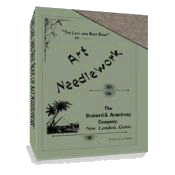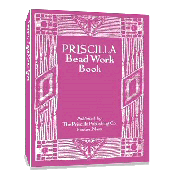Canvas Foundation Fabrics
Canvas was used in many, many Victorian projects. What many do not know, if new to this type of needlework, is that there are a number of different kinds of this material and each has its own best use.
Below is a list of foundation fabrics that were common during the Victorian era. Hopefully it will be an assistance to you if you come across one of these fabrics in a project that you are unsure of. If the particular fabric is no longer available, the description may help you determine a suitable replacement.
This information was published in Ladies' Fancy Work, by J. F. Ingalls in 1885. It has been edited for use on this site.
Foundation Fabrics
In commerce, the word " canvas" embraces certain varieties of fabric, each with the same predominating characteristic of permitting regular cross or single stitches to be made upon it in every direction.
Of late, many additions have been made, one of which is extremely desirable, on account of its texture and width, which renders it suitable for piano and table covers. We refer to
Plain Worsted Canvas - This fabric, extremely desirable on account of its texture and width, was woven of thick wool threads in the ordinary manner, two threads of warp and two of woof forming each square required for a cross stitch. It was generally worked in silk, crewel or filoselle, and was used for all the ordinary canvas work such as tidies, table covers, bureau covers as well as other furniture or piano spreads. It came in all shades of red, blue, buff, etc., as well as in black, and occasionally in white. Its widths, like nearly every variety of canvas, was half a-yard, three-quarters, one yard, and a yard and a-half.
Silk Canvas - This material was always used for fine work, which was for inspection rather than for service. It was generally embroidered in floss and beads or in either alone, and was used for glove and kerchief boxes, cases for spectacles, covers for fancy toilette cushions and boxes, and especially for bracket-lambrequins. It came in black, white and various tints, and requires no "filling in" after the design was worked, being a sufficiently handsome fabric in itself.
Java Canvas - This variety came in cotton and linen, and included the worsted material before mentioned. As the threads were finer, two were woven together so that four of the warp and four of the woof made the square or block marking out the stitch. It came in all the desirable shades, colors and widths, and was used for tidies, mats, sofa-pillows, slippers, covers for stools, bags for brushes, shoes, etc.
Panama Canvas - This fabric was straw-colored and straw-like in texture, and formed beautiful fancy articles for the table, such as baskets, mats, card-cases, etc. It was generally worked in crewel, split zephyr or silk.
Honey-Comb Canvas - This was a cotton canvas familiar to almost everyone, from the resemblance its surface had to honey-comb, except that the mesh was square instead of hexagona1. It was worked on the surface with long stitches of single worsted run under the threads forming the squares or meshes. The worsted run in for the border was cut off or looped at some distance from the edge, to form a fringe. It was used principally for toilette-sets for bureaus and washstands.
Railroad or Net Canvas - This was a stiff linen and cotton fabric in black or white, and woven in a large, open mesh. It required double worsted to work with, and could be filled in for a background or lined. Cross and star stitches were principally used for it, but it could be worked in the same way as honeycomb canvas. It was often used for tidies and sofa-pillows.
Mummy Canvas - This was a variety presenting the same surface as regular mummy cloth, except that it was woven in close, irregular-looking meshes. Even for experts, counting threads was necessary for regular work on this fabric, and therefore it was not advisable for beginners. It was handsome, however, and require no grounding or filling-in. The color was the natural linen tint, and the fabric could be worked with crewel, silk or zephyr. It was used for chair backs and seats, fancy camp stools, cushion-covers, sofa-pillows and any article requiring a strong foundation.
Ida Canvas - This was a new, unbleached linen material, which was woven in loose meshes that look as if they had once been embroidered and then had the work picked out again. It was just the thing for beginners, and was also preferred to the Java for some purposes. It was worked with single zephyr and silk floss.
Congress Canvas - For delicate tidies, covers, etc., to be done in fine crewel, floss or filoselle, this fabric was especially liked. Although it was really very strong, being made of hard, twisted linen threads, it looked like coarse or heavy tarlatan, without the stiffness of and with the transparency natural to the latter fabric. It was ornamented in stripes as follows: The length required was cut, and a satin ribbon, about No. 12, was basted through the middle, and one of another color at each side, so as to leave four spaces of canvas. The ribbon was fastened down at each edge, and at the center if desired, with fancy stitches in bright flosses. A floral pattern was then stamped between the ribbons, and was embroidered in one of the South Kensington stitches in natural colors with silk floss or filoselle. Tassels and the fringed ends of the ribbon finish the ends, and the sides were hemmed in a fancy stitch with bright flosses. It came in white, black and all the fancy tints, and was very dainty.
Fancy Canvases - Ida canvas, having its surface blocked off in two-and-a-half-inch diamond squares by a Grecian pattern that was woven in, constitutes a pretty background for several varieties of decoration. The squares were decorated in any fancy design in cross or backstitch, or with appliquéd classics, the Grecian effect being left either undecorated or otherwise, as the taste directed. This fabric was suitable for tidies, toilette sets, cushion-covers, chair-backs, etc., and was seen in unbleached and cream-white.
Another one was of worsted, and its squares were one inch and a-half in size, and were separated or marked out by inch-wide weavings in honeycomb pattern. The squares were worked in either cross-stitch or backstitch, and in any colors harmonious with the color of the material. For cushions and spreads it was very handsome.
Rug Materials
Sackcloth - better known as coffee-bagging - burlaps and a thick, coarse, unbleached canvas were generally selected for rugs. Berlin or Germantown wools and double zephyr were the embroidering materials. The bordering could be purchased and then embroidered along its heading and sewed on, or one could be crocheted along tile edge. Cross and star stitches were frequently used for rugs.
Aida Cloth
Today, the most common canvas type foundation used is Aida Cloth. Aida cloth is a coarse, open-weave, even-weave fabric used for cross-stitch embroidery. It is relatively stiff and is made from linen, cotton, or blends. It is made in a number of different sizes. The number relates to the number of holes between the warp and weft that accommodate the yarn or thread. A number 12-count Aida has 10 holes per linear inch, 14-count has 14 holes per liner inch, etc. Sizes commonly found are 7, 10, 11, 12 and 14 count. Colors available include neutral whites, off-whites, tans, and browns as well as many a multitude of colors. Aida cloth was introduced by Zweigart & Sawitzki, a leading textile company, in 1890 and has been a favorite since. Although Zweigart & Sawitzki marketed Aida cloth as a new cloth, it is generally believed that this cloth was formerly known as "Java Cloth."
The Last and Best Book of Art Needlework
Over 100 pages of authentic Victorian instructions and patterns from 1895!
FREE
Beeton's Book Of Needlework

433 pages!
Sign up for VEAC! Everything you wanted to know about Victorian embroidery, needlework, crafts and more!
Priscilla Bead Work Book
Make Beautiful Victorian Beaded Purses, Jewelry & Accessories - Starting
TODAY!



